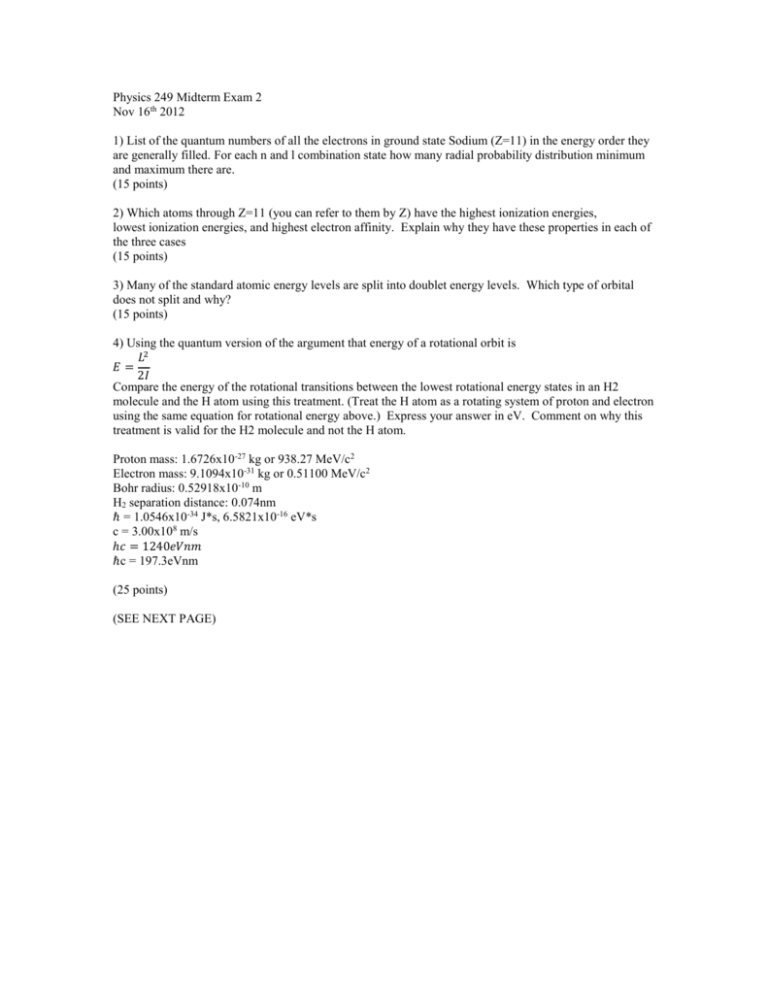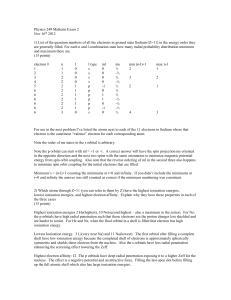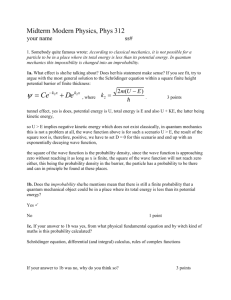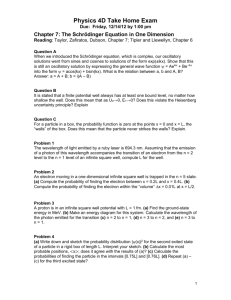exam2012_02
advertisement

Physics 249 Midterm Exam 2 Nov 16th 2012 1) List of the quantum numbers of all the electrons in ground state Sodium (Z=11) in the energy order they are generally filled. For each n and l combination state how many radial probability distribution minimum and maximum there are. (15 points) 2) Which atoms through Z=11 (you can refer to them by Z) have the highest ionization energies, lowest ionization energies, and highest electron affinity. Explain why they have these properties in each of the three cases (15 points) 3) Many of the standard atomic energy levels are split into doublet energy levels. Which type of orbital does not split and why? (15 points) 4) Using the quantum version of the argument that energy of a rotational orbit is 𝐿2 𝐸= 2𝐼 Compare the energy of the rotational transitions between the lowest rotational energy states in an H2 molecule and the H atom using this treatment. (Treat the H atom as a rotating system of proton and electron using the same equation for rotational energy above.) Express your answer in eV. Comment on why this treatment is valid for the H2 molecule and not the H atom. Proton mass: 1.6726x10-27 kg or 938.27 MeV/c2 Electron mass: 9.1094x10-31 kg or 0.51100 MeV/c2 Bohr radius: 0.52918x10-10 m H2 separation distance: 0.074nm ℏ = 1.0546x10-34 J*s, 6.5821x10-16 eV*s c = 3.00x108 m/s ℎ𝑐 = 1240𝑒𝑉𝑛𝑚 ℏc = 197.3eVnm (25 points) (SEE NEXT PAGE) 5) Calculate the rate of transmission for E>0 particles through a one dimensional delta function barrier potential at x=0: 𝑉(𝑥) = 𝜆𝛿(𝑥) where 𝜆>0. The delta function is infinite at x=0 and 0 everywhere else. This case is representative of the tunneling between a thin barrier between conductors since the potential is very high for an electron to be outside the wire. Qualitatively you can think of the delta "function" as the limit of a process, which starts with a square barrier, and reduces the thickness of the barrier, but increases the height of the barrier so that the area under the barrier function remains the same and the barrier is finally infinitesimally thin in space and infinitely high in space. Since, product of width times height of the potential barrier is finite the wave function does not have to be zero at x=0. (30 points, 5 points for each part) a) Write down the Schrödinger equation for this system. b) Write down a proposed wave equation solution. Hint: Since, product of width times height of the delta function potential barrier is finite, as in the finite potential barrier problem we solved, the wave function does not have to be zero at x=0 c) Write down an equation relating the wave functions at the region boundary. d) Write down an equation relating the first derivatives of the wave function at the region boundary. Hint: You can evaluate the form of the first derivative accounting for the impact of the delta function by integrating the Schrodinger equation in an infinitesimally small region, 𝑥 = −𝜀 to 𝑥 = −𝜀 around x=0 and considering the limit as that region shrinks to zero. Hint: By definition of the delta function: ∫ 𝑓(𝑥) 𝛿(𝑥)𝑑𝑥 = 𝑓(0) over any range including x=0. e) Solve the system of equations to understand the normalization constants of the transmitted wave compared to the incoming wave (the overall normalization constant does not need to be understood). f) Write down the transmission rate.











